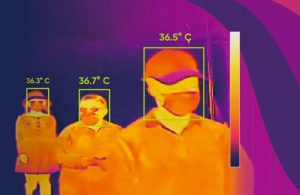Technology
How technology can automate COVID-19 safety checks and protect staff
David Armstrong, Managing Director of security firm, Centurion, explains how technology can automate COVID-19 processes.
It is no exaggeration to say that COVID-19 has turned the world upside down.
Businesses who care about customer retention, staff happiness and compliance need to take the threat of Covid-19 seriously.
Different environments require differing levels of procedures and processes – coined outbreak management. These business continuity arrangements are often implemented by people.
But employing staff to control processes is costly. Let’s take supermarkets as an example. If a store is open for an average of 13 hours a day, and there are two staff controlling the flow of people in and out, on an average wage of £12 per hour, it works out at £2,184 per week – or £113,568 per year – plus contributions.
The same cost principles can be applied to any setting which needs to limit the number of people in a certain area – garden centres, retail spaces, zoos and airports, to name a handful.
But these ‘roles’ can be automated using intuitive technology. Not only does such technology help to shield staff from potential risk, it also improves the customer experience and creates a return on investment.
Temperature monitoring
Building upon existing metal detection products, the addition of a temperature monitoring camera can provide public places such as schools, colleges and airports with an extra level of protection.
With a built-in screen which displays pass through numbers, body temperature and the recorded number of alarms, staff can be immediately alerted to potential COVID-19 cases. Detectors also support metal detection and are suitable for safety inspection of dangerous goods and pop-up environments, such as festivals or events.
Composer Andrew Lloyd Webber and Culture Secretary, Oliver Dowden, recently praised the metal detector safety technology as a ‘key way’ to reopen the entertainment industry.
It is also set to help students follow safety guidelines when schools reopen, with the technology becoming part of schools’ daily routines. Able to scan 70 people per minute, they create no lag in footfall, which is vital at the start of the day when many children enter the building at once.
Body temperature cameras

Image courtesy of IFSEC GLOBAL and Hikvision
With the introduction of temperature-monitoring cameras, some CCTV systems are now also able to quickly identify persons at risk of carrying COVID-19, helping staff to decide whether to allow them entry into the facilities. This knowledge has the potential to safeguard staff, and protect the bottom line, as fewer employees will require self-isolation or sick leave.
The customer experience isn’t affected by this process, as each person who enters doesn’t require individual testing, and there’s no lag in entry, as the system can test up to 30 people simultaneously. Only if someone is identified as a risk, will the customer notice any difference in their shopping experience at all.
Upon alert, retailers can then decide if they’d like to conduct a further level of testing, with the introduction of a handheld temperature monitor, carried out by a member of staff from a safe distance. Touchless access and exit buttons are also available, reducing the threat of infection spreading even further.
Flow control and people density
Flow control is where the technology starts to come into its own. Able to identify how many people are in a building and analyse traffic flow, visitor density monitoring can help to minimise overcrowding.
Cameras count people in and out of the building with a traffic light system, meaning that visitors are autonomously managed, without the need for staff to stand at the entrance.
CCTV systems with analytics can also provide intuitive reporting on directional paths, processes, inefficiencies and footfall, helping to recognise the most profitable products and peak hours, which drive better, well-informed business decisions. Using this information, directors are able to ascertain optimum staffing levels, product purchasing choices and placement.
Facial recognition access control
In buildings where security is a priority and access must be controlled, such as private offices; or restricted areas within a manufacturing facility; hands-free, temperature screening access control technology is now emerging.
Able to quickly take skin-surface temperature and upload an abnormal temperature event to a central control, the technology has multiple benefits.
For example, if the recognising face does not wear a mask, the device will prompt a voice reminder. At the same time, the authentication or attendance will be failed. Upon a valid entry, the system is able to open and close a secure door.
These measures, which would have seemed unthinkable just a few short months ago, now seem inevitable for businesses in all sectors.
For those who take the pandemic risk seriously, the decision to invest in such technology, is almost an easy one.
When it comes to ‘traditional’ CCTV, the return on investment is often recouped in a few short months, but when it comes to COVID-19, the payback is even shorter, particularly considering the goodwill gained from stakeholders.
And for those who realise the benefits of a powerful CCTV system, but don’t want to outlay the investment, leasing options are available.
How technology can automate COVID-19 safety checks and protect staff
A look at how technology can automate COVID-19 processes within businesses.
Safety & Health Practitioner
SHP - Health and Safety News, Legislation, PPE, CPD and Resources Related Topics
Drug and alcohol testing in a UK airport environment
Unleashing the power of emerging technologies in EHS
Passing the baton – Meet the 2024 IOSH President

